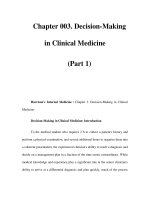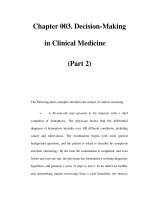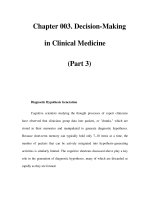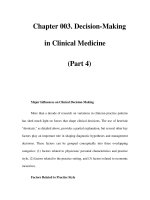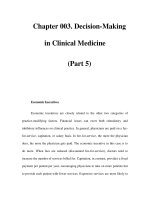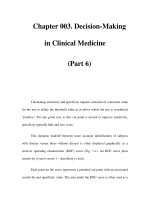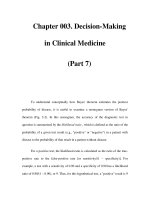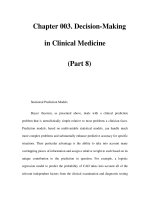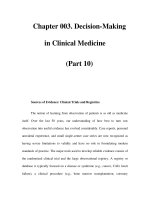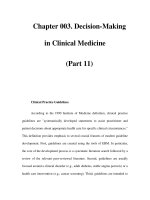Chapter 065. Gene Therapy in Clinical Medicine (Part 4) ppt
Bạn đang xem bản rút gọn của tài liệu. Xem và tải ngay bản đầy đủ của tài liệu tại đây (47.69 KB, 5 trang )
Chapter 065. Gene Therapy in
Clinical Medicine
(Part 4)
Another local approach uses adenoviral-mediated expression of the tumor
suppressor p53, which is mutated in a wide variety of cancers. This strategy has
shown complete and partial responses in squamous cell carcinoma of the head and
neck, esophageal cancer, and non-small cell lung cancer after direct intratumoral
injection of the vector. Response rates (~15%) are comparable to those of other
single agents. The use of oncolytic viruses that selectively replicate in tumor cells
but not in normal cells has also shown promise in squamous cell carcinoma of the
head and neck and in other solid tumors. This approach is based on the
observation that deletion of certain viral genes abolishes their ability to replicate in
normal cells but not in tumor cells. An advantage of this strategy is that the
replicating vector can proliferate and spread within the tumor, facilitating eventual
tumor clearance. However, physical limitations to viral spread, including fibrosis,
intermixed normal cells, basement membranes, and necrotic areas within the
tumor, may reduce clinical efficacy. Oncolytic viruses are licensed and available
in some countries, but not in the United States.
Because metastatic disease rather than uncontrolled growth of the primary
tumor is the source of mortality for most cancers, there has been considerable
interest in developing systemic gene therapy approaches. One strategy has been to
promote more efficient recognition of tumor cells by the immune system.
Approaches have included transduction of tumor cells with immune-enhancing
genes encoding cytokines, chemokines, or co-stimulatory molecules. Sustained
clinical responses provide evidence that the transduced cells can act as a vaccine.
In a related approach, patient lymphocytes have been transduced with genes
encoding a T cell receptor–like molecule, with a tumor antigen–binding domain
fused to an intracellular signaling domain to allow T cell activation, thereby
converting normal lymphocytes into cells capable of recognizing and destroying
tumor cells. A third immunotherapy approach relies on ex vivo manipulation of
dendritic cells to enhance the presentation of tumor antigens. These immunologic
approaches may be of particular value in treating minimal residual disease after
other anticancer modalities.
Gene transfer strategies have also been developed for inhibiting tumor
angiogenesis. These have included constitutive expression of angiogenesis
inhibitors such as angiostatin and endostatin; use of siRNA to reduce levels of
VEGF or VEGF receptor; and combined approaches in which autologous T cells
are genetically modified to recognize antigens specific to tumor vasculature. These
studies are still in early-phase testing.
Another novel systemic approach is the use of gene transfer to protect
normal cells from the toxicities of chemotherapy. The most extensively studied of
these approaches has been transduction of hematopoietic cells with genes
encoding resistance to chemotherapeutic agents, including the multidrug resistance
gene MDRI or the gene encoding O
6
-methylguanine DNA methyltransferase
(MGMT). Ex vivo transduction of hematopoietic cells, followed by autologous
transplantation, is being investigated as a strategy for allowing administration of
higher doses of chemotherapy than would otherwise be tolerated.
Gene Therapy for Vascular Disease
The third major category addressed by gene transfer studies is
cardiovascular disease. The most extensive experience has been in trials designed
to increase blood flow to either skeletal (critical limb ischemia) or cardiac muscle
(angina/myocardial ischemia). Initial treatment options for both of these groups
include mechanical revascularization or medical management, but a subset of
patients are not candidates for, or fail, these approaches. These patients have
formed the first cohorts for evaluation of gene transfer to achieve therapeutic
angiogenesis. The major transgene used has been VEGF, attractive because of its
specificity for endothelial cells; other transgenes have included fibroblast growth
factor (FGF) and hypoxia-inducible factor 1, αsubunit (HIF-1α). The design of
most of the trials has included direct IM (or myocardial) injection of either a
plasmid or an adenoviral vector expressing the transgene. Both of these vectors are
likely to result in only short-term expression of VEGF. This strategy may be
adequate, however, as there is no need for continued transgene expression once the
new vessels have formed. Direct injection favors local expression, which should
help to avoid systemic effects such as retinal neovascularization or new vessel
formation in a nascent tumor. Initial trials of adeno-VEGF or plasmid-VEGF
injection have resulted in improvement over baseline in terms of frequency of
claudication/angina or amounts of nitroglycerin consumption. Study designs
including placebo control groups and more objective endpoints (exercise duration
at 3 or 6 months, rest and stress cardiac perfusion scans, and regional wall motion
assessed by nonfluoroscopic electroanatomic mapping) continue to suggest a
beneficial effect of gene transfer, although definitive conclusions will require
larger studies. Continuing areas of investigation include choice of the optimal
vector (adenoviral vs. plasmid), the optimal transgene (VEGF, HIF-1α, FGF, etc.),
the optimal method of delivery in cardiac indications (intracoronary vs. direct
myocardial), ideal objective endpoints, and whether concurrent administration of
cytokines to mobilize endothelial progenitor cells will augment the therapeutic
effect.
